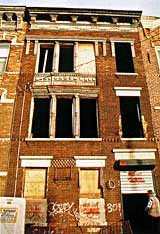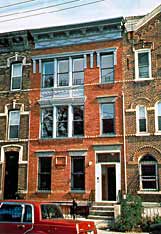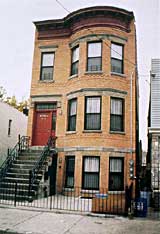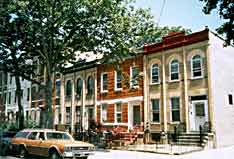 |
|
Project Summary: MHANY Scattered Site
OWNER/DEVELOPER
Mutual Housing Assoc. of N.Y.
ARCHITECT
Pratt Planning and Architectural Collaborative
CONTRACTORS
Clermont G.C.; Cracovia G.C.; H & V Allen Constr.;
Penn Constr.; The Loranco Corp.; Strategic Constr.;
Strathairn Construction.
| FUNDERS: | TYPE: |
| The Meyer Parodneck Foundation | Servicing agent |
| ACORN | Admin. budget |
| NYC. Dept. of Hsg., Preserv. & Dev. (HPD) | Loan/land |
| N.Y. Landmarks Conservancy | Loan |
| HUD | HOME grant |
| Chemical Bank | Recoverable loans |
| East New York Savings Bank | Recoverable loans |
| Bank of N.Y. | Recoverable loans |
DEVELOPMENT TYPE:
Rehabilitation, scattered-site, co-operative, attached townhouses.
RESIDENT PROFILE:
Low-income families with max. income $28,500 for family of 4.
DENSITY: Average 54 units per acre
DEVELOPMENT PROFILE
| Type | #/Units | Size (sf) | Rents |
| Studio | 16 | 350-400 | $325 |
| 1 BR | 9 | 510-650 | $375 |
| 2 BR | 31 | 640-750 | $425 |
| 3 BR | 105 | 760-900 | $475 |
| 4 BR | 108 | 930-1,100 | $525 |
| 5 BR | 54 | 1,100-1,600 | $575 |
| 6 BR | 10 | 1,800 | $575 |
| Total | 322 | | |
Parking: 0 - on street
Laundry: In cellar
Courtyard: Two playlots, private rear yards
Retail: One storefront
|
CONSTRUCTION TYPE
Two- ,three-, and four-story brick exterior walls, wood & steel framing.
DEVELOPMENT COSTS:
Land cost: $1/lot; Constr. costs: $24,021,227 (ave. $74,600/unit); Other costs: $5,765,094
(ave. $17,504/unit); Total development costs: $29,786,321 (ave. $92,504/unit).
|
|
|
MUTUAL HOUSING ASSOCIATION Infill Housing, Brooklyn, New York
 In 1985, local residents acting with the Association of Community Organizations for Reform Now (ACORN) occupied 25 vacant, city-owned buildings in the East New York section of Brooklyn causing a political uproar. Two years later, the Pratt Institute Center for Community and Environmental Development (PICCED) and the Consumer Farmer Foundation (now the Meyer Parodneck Foundation), negotiated a deal. The squatters agreed not to take over any more buildings and to become "homesteaders" and members of a new entity, the Mutual Housing Association of New York (MHANY). This gave them a legal status that allowed the City to grant them title to their apartments and to allocate $2.7 million of a revolving loan fund to finance rehabilitation work and to pay for technical assistance. In 1985, local residents acting with the Association of Community Organizations for Reform Now (ACORN) occupied 25 vacant, city-owned buildings in the East New York section of Brooklyn causing a political uproar. Two years later, the Pratt Institute Center for Community and Environmental Development (PICCED) and the Consumer Farmer Foundation (now the Meyer Parodneck Foundation), negotiated a deal. The squatters agreed not to take over any more buildings and to become "homesteaders" and members of a new entity, the Mutual Housing Association of New York (MHANY). This gave them a legal status that allowed the City to grant them title to their apartments and to allocate $2.7 million of a revolving loan fund to finance rehabilitation work and to pay for technical assistance.
 This was the first test in New York City of mutual housing, a much-discussed low-income housing development in which a city would give a neighborhood collective of homesteaders money and technical assistance to rehabilitate buildings for their own use in return for restrictions on their resale rights. When a family decides to move, MHANY has the first option to buy the unit for resale to a member on the waiting list and can restrict the sale price, thereby maintaining long term affordability. MHANY membership is open to any New York City resident whose family income is less than 80 per cent of the area median income and who is not a city property owner. This was the first test in New York City of mutual housing, a much-discussed low-income housing development in which a city would give a neighborhood collective of homesteaders money and technical assistance to rehabilitate buildings for their own use in return for restrictions on their resale rights. When a family decides to move, MHANY has the first option to buy the unit for resale to a member on the waiting list and can restrict the sale price, thereby maintaining long term affordability. MHANY membership is open to any New York City resident whose family income is less than 80 per cent of the area median income and who is not a city property owner.
 In the ten years since the original protest squat, the program has evolved. In the beginning the rehabilitation tasks were divided between the homesteaders and the contractors. However, the slow pace of these early projects and the growing list of new applicants forced a shift to the use of contractors for everything but painting of the interiors. Today, although architects from the Pratt Architectural and Planning Collaborative develop plans and supervise the construction, MHANY members still must do at least 40 hours work either painting or cleaning out rear yards to qualify for an apartment. Homeowners also select the colors and patterns for the bath tile, countertops, and kitchen flooring. In the ten years since the original protest squat, the program has evolved. In the beginning the rehabilitation tasks were divided between the homesteaders and the contractors. However, the slow pace of these early projects and the growing list of new applicants forced a shift to the use of contractors for everything but painting of the interiors. Today, although architects from the Pratt Architectural and Planning Collaborative develop plans and supervise the construction, MHANY members still must do at least 40 hours work either painting or cleaning out rear yards to qualify for an apartment. Homeowners also select the colors and patterns for the bath tile, countertops, and kitchen flooring.
The buildings in the MHANY program range in size from single-family houses to nine-unit buildings and are now located in three other Brooklyn neighborhoods. The program validates the use of the older building stock, which permits a density that could not be re-created in new construction. Some of these large units have enough space for small business activities such as tailoring, bicycle repair, or catering.
 In cities like New York, which have a great number of vacant buildings and an even greater number of people waiting for public housing, this is a very attractive type of program. It is a grass-roots effort to repair the physical and social fabric of a damaged neighborhood using existing housing stock, sweat-equity, and a local workforce. E. Perry Winston, senior architect of the Pratt Collaborative and project manager for MHANY from 1990-95, called the program, "One of the best I have worked on from the point of view of long-term affordability, size of units, quality of materials, opportunity of resident participation, involvement of small local contractors, pace of production, and cumulative impact on the physical environment." In cities like New York, which have a great number of vacant buildings and an even greater number of people waiting for public housing, this is a very attractive type of program. It is a grass-roots effort to repair the physical and social fabric of a damaged neighborhood using existing housing stock, sweat-equity, and a local workforce. E. Perry Winston, senior architect of the Pratt Collaborative and project manager for MHANY from 1990-95, called the program, "One of the best I have worked on from the point of view of long-term affordability, size of units, quality of materials, opportunity of resident participation, involvement of small local contractors, pace of production, and cumulative impact on the physical environment."
|



